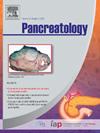Prognostic impact of post-neoadjuvant CA19-9 values in pancreatic cancer: more pronounced following neoadjuvant chemotherapy compared to neoadjuvant chemoradiotherapy
IF 2.7
2区 医学
Q2 GASTROENTEROLOGY & HEPATOLOGY
引用次数: 0
Abstract
Background/objectives
Neoadjuvant treatment (NAT), including chemotherapy (NAC) and chemoradiation therapy (NACRT), is a promising approach to treat pancreatic cancer (PC). Alterations in serum carbohydrate antigen 19-9 (CA19-9) following NAT have been studied as outcome indicators. The impact of adding radiation therapy (RT) to NAT on the prognostic significance of changes in CA19-9 is unclear. This study compares changes in CA19-9 levels following NAC vs. NACRT with regard to prognosis.
Methods
Patients with resectable or borderline resectable PC who underwent curative resection after either NAC or NACRT were enrolled. A cutoff value of 100 U/mL for post-NAT CA19-9 was established, and its association with prognosis was investigated in both the NAC and NACRT groups.
Results
No significant difference was observed in survival between the NAC and NACRT groups. While both groups showed clear stratification according to the CA19-9 cutoff for overall survival and disease-free survival, a significant difference in survival after recurrence (SAR) was observed only in the NAC group. Among patients with post-NAT CA19-9 levels <100 U/mL, the NAC group had a significantly higher 2-year survival rate and more favorable SAR than did the NACRT group. Conversely, among patients with values above the cutoff, no significant prognostic differences were observed between the two groups.
Conclusions
The prognostic significance of post-NACRT CA19-9 values is suboptimal compared to post-NAC CA19-9 values.
胰腺癌新辅助后CA19-9值对预后的影响:与新辅助放化疗相比,新辅助化疗后CA19-9值更明显。
背景/目的:新辅助治疗(NAT),包括化疗(NAC)和放化疗(NACRT),是治疗胰腺癌(PC)的一种很有前途的方法。研究了NAT后血清碳水化合物抗原19-9 (CA19-9)的变化作为预后指标。放疗加放疗对CA19-9变化的预后意义尚不清楚。本研究比较了NAC与NACRT后CA19-9水平对预后的影响。方法:纳入在NAC或NACRT后行根治性切除的可切除或边缘性可切除PC患者。建立nat后CA19-9的临界值为100 U/mL,并在NAC组和NACRT组中研究其与预后的关系。结果:NAC组与NACRT组的生存率无显著差异。虽然两组根据CA19-9的总生存期和无病生存期的截止时间显示出明确的分层,但只有NAC组在复发后生存期(SAR)上观察到显著差异。结论:与nac后的CA19-9值相比,nacrt后CA19-9值的预后意义并不理想。
本文章由计算机程序翻译,如有差异,请以英文原文为准。
求助全文
约1分钟内获得全文
求助全文
来源期刊

Pancreatology
医学-胃肠肝病学
CiteScore
7.20
自引率
5.60%
发文量
194
审稿时长
44 days
期刊介绍:
Pancreatology is the official journal of the International Association of Pancreatology (IAP), the European Pancreatic Club (EPC) and several national societies and study groups around the world. Dedicated to the understanding and treatment of exocrine as well as endocrine pancreatic disease, this multidisciplinary periodical publishes original basic, translational and clinical pancreatic research from a range of fields including gastroenterology, oncology, surgery, pharmacology, cellular and molecular biology as well as endocrinology, immunology and epidemiology. Readers can expect to gain new insights into pancreatic physiology and into the pathogenesis, diagnosis, therapeutic approaches and prognosis of pancreatic diseases. The journal features original articles, case reports, consensus guidelines and topical, cutting edge reviews, thus representing a source of valuable, novel information for clinical and basic researchers alike.
 求助内容:
求助内容: 应助结果提醒方式:
应助结果提醒方式:


